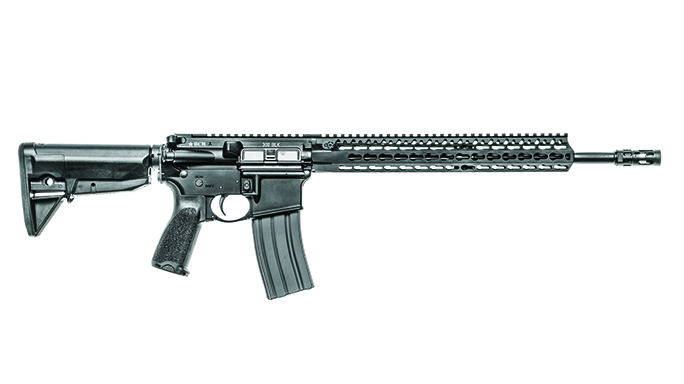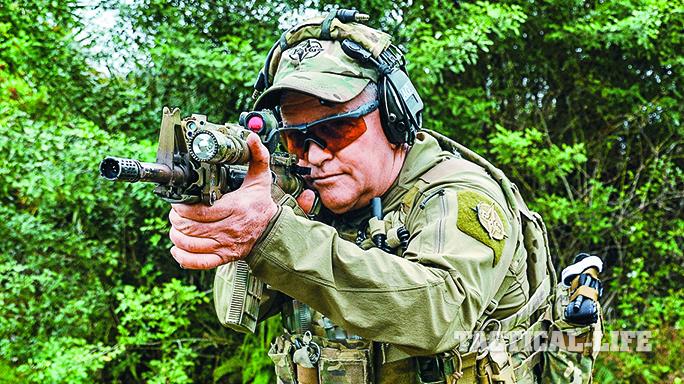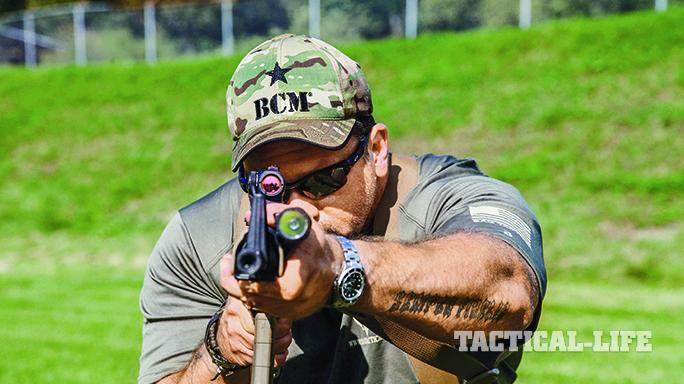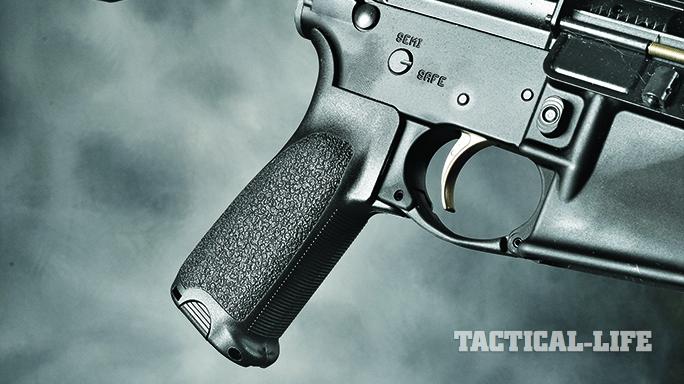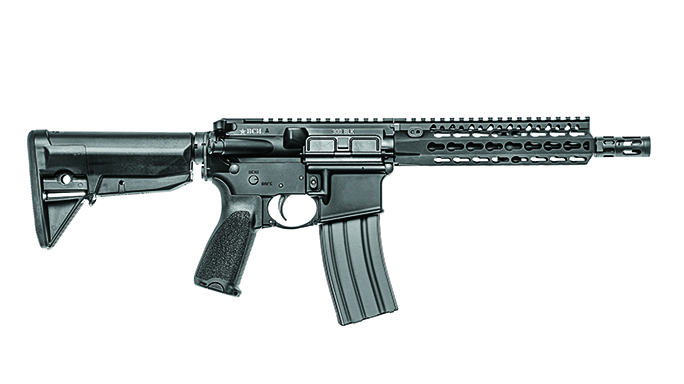In 2003, Paul Buffoni started a small online and e-commerce company in the basement of his home. Buffoni’s goal was to provide high-quality, mil-spec products to military and law enforcement customers. This expanded to include overseas contractors and the general commercial market that needed quality AR/M4 components. Now, some 13 years later, Bravo Company Manufacturing (BCM) has grown to over 30 employees and occupies a 30,000-square-foot manufacturing facility. BCM’s line of products has also grown to include barrels, upper receivers, stocks, pistol grips and a complete line of duty-ready rifles. All of BCM’s products are manufactured to exacting specifications. To quote Buffoni, “I look at firearms the same way a paratrooper looks at his parachute. It is going to save his life and if it doesn’t, there are going to be dire consequences.”
The BCM Gunfighter accessory line has become a research and development skunk works and has produced some of the best accessories on the market. As a retired U.S. Marine, Buffoni understands that ounces equal pounds and pounds equal pain. However, strength and reliability can’t be compromised along the way when it comes to developing weapons. Nowhere is this more evident than with the BCM KeyMod Rail-Alpha (KMR-A) handguard system. In addition, BCM’s pistol grips and stocks are also extremely popular due to their durability and ergonomic designs.
- RELATED STORY: Alpha Dog – Bravo Company’s RECCE-16 KMR-A Rifle
BCM is a company that I have followed through the press and through the late Pat Rogers of EAG Tactical. I first met Pat in 1996 when he instructed a Gunsite course at Ft. Benning, Georgia. Since that time, Pat completed a successful career with both the NYPD and the U.S. Marine Corps. Before his passing earlier this year, Pat’s tactical training and his shoothouse/CQB classes were in high demand by both the law enforcement and military communities. Pat was a traditional New York kind of guy (translation: He was not concerned about being politically correct or whose feelings he hurt). He was opinionated and, based on his experience and wealth of knowledge, his opinions are still well respected. If you search YouTube, will find several videos of Pat sharing his experiences with BCM rifles in some of the most extreme environments. So it was high praise when Pat Rogers endorsed BCM.
Advertisement — Continue Reading Below
RECCE Rifles
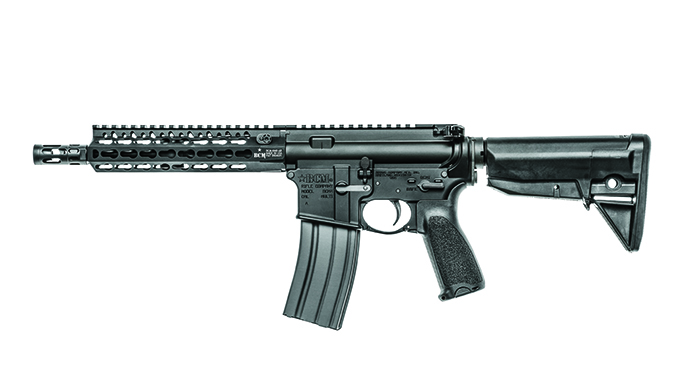
BCM recently introduced its new 300 Blackout RECCE KMR-A rifles in both 16-inch-barreled carbine and 9-inch-barreled SBR configurations. I received both a 16-inch-barreled carbine and an SBR upper receiver to evaluate. Having tested close to a dozen 300 BLK rifles in the past several years, I was extremely interested in a BCM carbine in this caliber. When I received the rifle and upper, I was immediately struck by how clean and well finished they were. In addition, the weight and balance of the 16-inch-barreled carbine seemed perfect.
Every BCM rifle starts with receivers that are machined from hardcoat anodized 7075-T6 aluminum. The upper receivers feature M4 feed ramps and barrel extensions. The BCM RECCE lower receiver is a typical mil-spec unit with standard operating controls and fire control components. The bolt is shot peened and high-pressure (HP) and magnetic-particle (MP) inspected. To reduce corrosion and extend service life, the gas key and bolt carrier are hard chromed.
Advertisement — Continue Reading Below
WEAPON SPECs
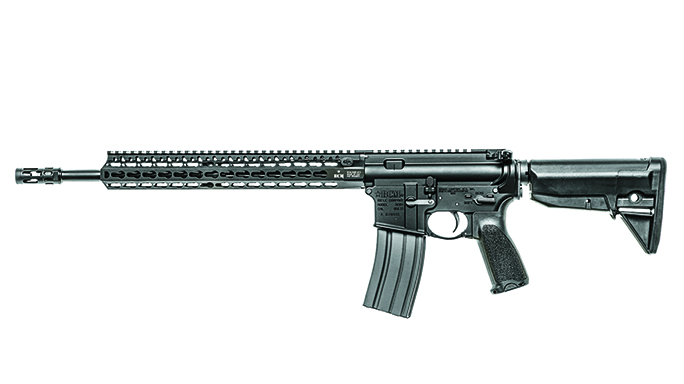
At the heart of any rifle is the barrel. The 16-inch BCM barrel is manufactured from 11595E certified steel, and it has an enhanced profile that is fluted behind the gas block to decrease weight and help dissipate barrel heat. Forward of the gas block, the barrel is tapered to reduce weight and improve the carbine’s balance. The bore and chamber are chrome lined while the exterior is finished in manganese-phosphate. The barrel is fitted with the BCM Gunfighter Mod 1 compensator, which features tuned slots and an interior cone to mitigate recoil and muzzle flash. The design also minimizes the over-pressure and “crack” that is found with some other designs.
- RELATED STORY: Gun Review – Bravo Company’s Elite RECCE-18 Rifle
The carbine has standard mil-spec operating controls, including a single-sided safety, bolt release and magazine release. The BCM Gunfighter Mod 4 charging handle is machined from 7075-T6 billet aluminum and features an extended, medium-sized latch. BCM charging handles are designed to be compatible with the current CQB techniques that call for the user to manipulate the charging handle from only the left side of the receiver.
Advertisement — Continue Reading Below
Of course, the carbine features a 13-inch KMR-A rail, which has been designed to be lightweight without sacrificing strength. With mounting hardware, it weighs a mere 9.2 ounces and is only 6.25 inches in diameter. By comparison, the Knight’s Armament URX rail, while not a KeyMod system, measures 7.75 inches in diameter. BCM also offers KeyMod Rail Panels that are made of polymer and snap into place to provide enhanced traction. The panels are available in four colors and may be cut to any length. The edges of the panels are rounded, and each panel has vent cuts to improve airflow around the barrel.
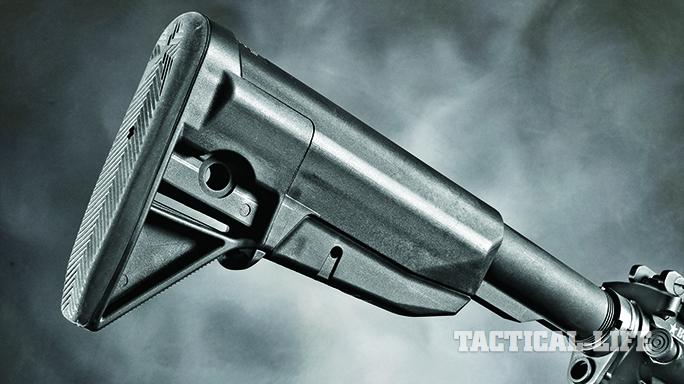
The RECCE carbine comes standard with BCM’s Gunfighter Mod 3 grip and stock. The Mod 3 grip has a reduced angle and a high-rise beavertail backstrap for improved ergonomics and trigger control. It also has a trapdoor for internal storage as well as an extended tang to fill the gap between the grip and the triggerguard. The BCM Gunfighter stock is a low-profile and snag-free design with no edges or openings to get hung up on the shooter’s gear. QD sling connections are located on each side of the stock, and a sling slot allows for the use of non-QD slings. One unique feature is the VBOST (Vehicle Borne Operations Sling Tab) that interfaces with a rigger’s band or bungee used to secure the sling against the stock. Finally, its contoured rubber buttplate ensures a positive mounting surface.
The RECCE SBR I tested featured a 9-inch, 1-in-7-inch-twist barrel, an 8-inch KMR-A handguard and BCM backup sights. I installed the Gunfighter stock and Mod 3 pistol grip on a registered SBR lower for the evaluation. In addition, I installed a BCM Kinesthetic Angled Grip (KAG). The KAG is designed to give positive retention when using the thumb-over-bore “C-clamp” method for holding the rifle. The KAG mounted directly to the KMR-A rail and works well with both the C-clamp and more traditional methods. I found that it provided a consistent and safe support hand index, which is critical on SBRs. I also installed a flush-fit QD receptacle at the 11 o’clock position, just forward of the receiver, and installed a Blue Force Gear Vickers Sling.
Advertisement — Continue Reading Below
Dual-Gun Thunder
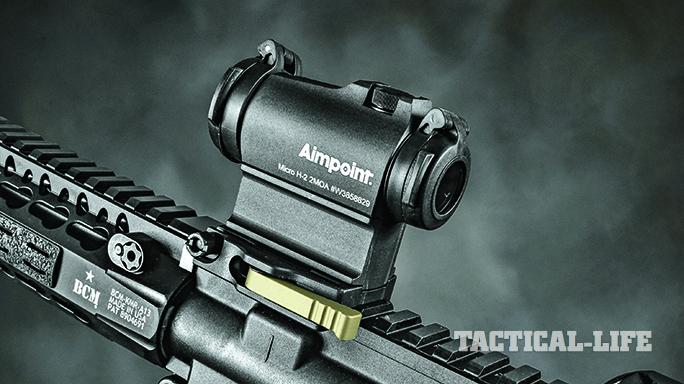
BCM’s website and literature is up front when it comes to the reliability of its 300 BLK rifles. With loads ranging from 110 to 220 grains, reliability is directly dependent on how the rifle is gassed and what buffer weight is used. BCM recommends running its rifles with a carbine buffer when using subsonic ammunition and an H3 buffer when using high-velocity ammunition. This became extremely important when we hit the range to wring out the 16-inch-barreled carbine and the 9-inch-barreled SBR. Both were 100-percent reliable when using the appropriate-weight buffer.
- RELATED STORY: 5 Elite KeyMod UpGrades From Bravo Company
I was fortunate to have a large variety of 300 BLK loads on hand when range day came. As a result, we were able to test both guns with six different loads. The two supersonic loads were PNW’s 125-grain Nosler Ballistic Tip hunting ammo as well as PNW’s 147-grain FMJ range load. We also tested four subsonic loads. These included PNW’s 220-grain Sierra MatchKing OTMs, Gorilla’s 220-grain Sierra MatchKings and Hornady’s 208-grain A-MAX ammo. The final subsonic load was Gemtech’s 187-grain FMJs.
Advertisement — Continue Reading Below
For 100-yard accuracy testing, I installed a Leupold 2.5-8x36mm Mark 4 scope using a LaRue Tactical SPR mount. As the accompanying chart reflects, the 16-inch-barreled gun was more than capable of providing groups of 1.5 inches or less. The 1-in-7-inch-twist barrel worked very well with the 125-grain PNW load, which had the lowest extreme spread and standard deviation. This ammo also produced the best group of the day, measuring 0.75 inches. Both the 220-grain Gorilla and PNW loads produced 1-inch groups.
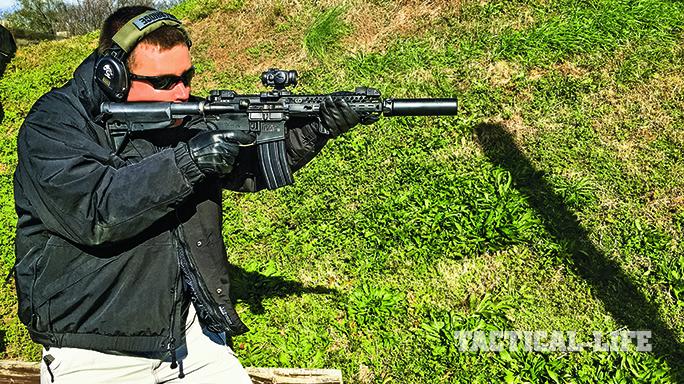
The little 9-inch-barreled SBR, while designed primarily as a CQB platform, produced some impressive groups. At 50 yards, the SBR created 0.3- and 0.8-inch groups with the 220-grain PNW and Gorilla loads, respectively. The little gun also liked the 125-grain PNW load, which produced a 0.5-inch group. We then moved out to 100 yards where the 9-inch-barreled gun produced some exceptional groups.
We were fortunate to be shooting at the Strongpoint Shooting Complex located outside Waverly Hall, Georgia. The complex has been renamed and is under new management. Recent improvements include pushing the rifle range to 400 meters and installing steel targets. We found that engaging targets out to 300 yards, with any of the supersonic loads, was relatively easy with the Leupold Mark 4 scope on the 16-inch-barreled carbine and an Aimpoint Micro T-2 sight installed on the 9-inch-barreled SBR. With the subsonic loads, we found that hits at 200 yards were predictable once the holdover was established. We also ran the carbine with the new Aimpoint Micro H-2 that is now being issued to the FBI’s tactical teams. The sight’s crisper 2-MOA dot was a major advantage when engaging targets beyond 200 yards. Headshots were easy.
Advertisement — Continue Reading Below
With a little more work, we were able to make hits at 300 yards with the subsonic ammo. Using a ballistic calculator, we established the holdover at 300 yards to be roughly 35 MOA with the 16-inch-barreled gun and 44 MOA with the 9-inch-barreled gun. Surprisingly, the calculator projected the 300-yard velocity of the 220-grain SMK to be 920 fps from the 16-inch barrel and 821 fps from the 9-inch barrel. We also found that the 147-grain PNW “range” load was surprisingly effective when engaging steel out to 300-plus yards.
Knowing that it would be an injustice if we did not shoot one of the BCM RECCE carbines suppressed, I installed a SureFire flash suppressor/adapter on the 9-inch-barreled SBR. Using an older SureFire Mini 7.62 suppressor, the little SBR ran like a top with both supersonic and subsonic loads. The Mini 7.62 is the older version of the SOCOM762-MINI.
At the end of the evaluation, I regretted not getting a BCM rifle sooner. The ergonomics of the Gunfighter stock and grip were perfect, and I’m sold on the new KMR-A rail. I am certainly going to add these accessories to some of the rifles in my safe. For those looking for a durable and comfortable carbine, BCM should be your first stop.
Advertisement — Continue Reading Below
For more information, visit http://www.bravocompanyusa.com or call 877-272-8626.
This article was originally published in ‘AR Rifleman’ #189. For information on how to subscribe, please email subscriptions@

